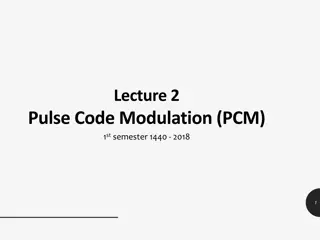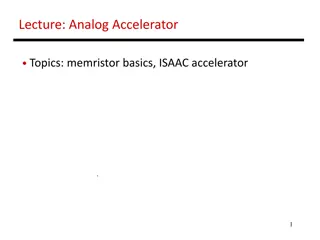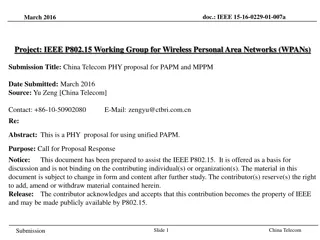Analog Computer Simulation of Mechanical Oscillations with Damping
Explore the analog computer simulation of mechanical oscillations with and without damping in a physics-themed project. Students can visualize classical physics concepts through hands-on analog circuit design, modeling spring-mass systems and RLC circuits. The project involves constructing a breadbo
15 views • 11 slides
SSB-SC Modulation in Analog Communication
Single Sideband Suppressed Carrier (SSB-SC) modulation is a technique in analog communication that transmits a single sideband along with the carrier signal, offering advantages such as reduced bandwidth consumption, increased signal transmission capacity, and lower noise interference. However, the
3 views • 9 slides
Digital Communication and Sampling Theory in Computer Engineering
Digital communication in the context of computer engineering involves representing information in binary form for transmission. Sampling theory plays a key role in pulse modulation techniques, noise management, and modulation schemes like ASK, PSK, FSK, and QPSK. This course covers various topics su
13 views • 14 slides
Analog Data and Digital Signal Transmission
This lecture delves into the concepts of analog data, digital signals, and the processes involved in data transmission and digital communication. It covers topics such as Pulse Amplitude Modulation (PAM), Analog-to-Digital Conversion, and Sampling. The conversion of analog signals to digital signals
7 views • 34 slides
Pulse Code Modulation (PCM) in Analog to Digital Conversion
This content delves into the realm of Pulse Code Modulation (PCM), outlining its significance in converting analog data to digital signals. It covers the process of Analog to Digital Conversion, emphasizing the advantages of digitizing analog signals for improved quality and reduced noise. The steps
6 views • 14 slides
Digital Modulation in Data Transmission
Delve into the world of digital modulation for data transmission, exploring various modulation schemes, digital-to-analog conversion processes, the importance of digital modulation in mixed networks, and the fundamentals of modulation and demodulation.
3 views • 27 slides
Modulation in Data Transmission and Digital Communication
Modulation plays a crucial role in data transmission and digital communication by altering the characteristics of a carrier signal based on the message signal. This lecture discusses analog and digital modulation techniques such as AM, FM, PM, and their operations. It covers the basics of amplitude
4 views • 33 slides
Signal Encoding Techniques in Networks and Communication
This chapter delves into signal encoding techniques used in digital data transmission, covering key concepts such as encoding schemes like NRZ-L and NRZI, multilevel binary encoding, and biphase encoding. It explores the fundamentals of digital signaling, modulation techniques, and the relationship
9 views • 34 slides
Analog Accelerator: Memristor Basics and ISAAC Accelerator
Explore the world of analog acceleration with topics covering memristor basics and the ISAAC accelerator. From understanding noisy analog phenomena to leveraging wires as ALUs, delve into crossbars for vector-matrix multiplication and the challenges of high ADC/DAC area/energy. Discover solutions li
6 views • 23 slides
Comparison of Unequal Modulation and Unequal MCS in IEEE 802.11-23
The comparison between Unequal Modulation and Unequal MCS in the context of IEEE 802.11-23 discusses how these techniques handle spatial streams, modulation schemes, and coding rates to optimize throughput and MIMO gains. Unequal Modulation focuses on adjusting modulations per stream based on SNR co
3 views • 10 slides
Modulation and Tonal Hierarchies in Music Perception
This research explores how expertise influences the perception of modulation in Western and South Indian classical music, focusing on tonal hierarchies, pitch importance, modulation processes, and memory for melodies. Through experiments involving listeners rating probe tones against music excerpts,
11 views • 26 slides
Maximizing Throughput in IEEE 802.11 Networks Through Unequal Modulation Strategies
The documents discuss the benefits of using unequal modulation over spatial streams in IEEE 802.11 networks to enhance throughput. Unequal modulation allows for adapting modulation schemes based on Signal-to-Noise Ratio (SNR) conditions, optimizing MIMO gains and coding rates for each spatial stream
0 views • 10 slides
Introduction to Arduino DAC and PWM in Embedded Systems Lab
Explore the practical application of Arduino's digital-to-analog converter (DAC) and pulse width modulation (PWM) techniques through projects involving RGB LED modules, analog joysticks, and stepper motors. Learn to control RGB LED colors, read analog joystick input values, and operate stepper motor
1 views • 10 slides
9. Multi Carrier Modulation and OFDM
Explore the concepts of multi-carrier modulation, OFDM, single-carrier modulation, channel equalization, and the benefits of using a multi-carrier approach in wireless communication systems. Understand the differences between single-carrier and multi-carrier modulation in handling time-varying chann
0 views • 36 slides
Automatic Modulation Recognition Using Generative Adversarial Networks
In the realm of spectrum sensing, the demand for automatic modulation recognition (AMR) has intensified due to the scarcity of spectrum resources. This study delves into the utilization of Generative Adversarial Networks (GAN) to automate AMR, a departure from manual methods. By employing GAN's gene
2 views • 13 slides
Angle Modulation: Frequency and Phase Variations
Angle modulation involves varying the frequency or phase of a carrier signal based on the modulating signal. Frequency Modulation (FM) and Phase Modulation (PM) are types of angle modulation that offer better noise discrimination. This results in improved robustness against interference but comes at
0 views • 23 slides
Analog-to-Digital Converter
This content delves into the fundamental concepts and practical applications of analog-to-digital conversion (ADC). Learn how ADC enables the transformation of analog signals into digital data for processing, explore the importance of sampling intervals, and grasp the significance of digital signal
0 views • 43 slides
Determination of PDH Modulation Frequency
This article by Daisuke TATSUMI from the National Astronomical Observatory of Japan discusses the determination of PDH modulation frequencies in the context of frequency domain interferometer simulation. The content focuses on the intricacies of selecting the appropriate modulation frequency for acc
0 views • 10 slides
Digital Transmission and Analog to Digital Conversion Overview
This content covers concepts related to data transmission, digital communication, analog-to-digital conversion, and more. Explore topics such as Pulse Code Modulation, sampling, quantizing, encoding, Nyquist Theorem, sampling methods, and the significance of digital signals over analog. Gain insight
3 views • 34 slides
Introduction to Modulation Techniques in Mobile Radio
Modulation is the process of encoding baseband information for transmission, while demodulation extracts the original message. This includes analog and digital modulation methods like Amplitude Modulation (AM). Understanding these techniques is vital for efficient signal transmission in mobile radio
3 views • 45 slides
Analog Output and PWM in Physical Computing
Explore the concept of analog output and Pulse Width Modulation (PWM) in physical computing. Learn how to generate analog voltage using digital pins and control LED brightness. Understand the equation for calculating average voltage output.
1 views • 17 slides
Modulation and Demodulation
Learn about modulation and demodulation processes in telecommunications, where signals are encoded and transmitted through carrier waves. Explore various types of modulation techniques such as amplitude, frequency, and phase modulation, along with their applications.
5 views • 20 slides
Advanced Modulation Techniques and Simulink Implementation
Explore standard Amplitude Modulation (AM), Frequency Modulation (FM), and Phase Modulation (PM) techniques using Simulink software. Learn to generate, view effects, and analyze AM signals. Discover blocks required for FM modulation and integration, gain operations, and more.
0 views • 20 slides
Advanced Modulation Classification Techniques
Explore the world of modulation classification, from the basics of modulation schemes like PSK and QAM to advanced techniques like Automatic Modulation Classification (AMC) using Machine Learning. Dive into literature surveys on Convolutional Radio Modulation Recognition Networks and Over-the-Air De
4 views • 14 slides
MATLAB Communication Systems Design with Analog Modulation Functions
Explore the design of communication systems using MATLAB, focusing on analog communications and digital communications. Learn about signal modulation, demodulation, and key functions like amplitude modulation and demodulation in MATLAB for effective system design and simulation.
4 views • 83 slides
AM (DSB+C): Modulation and Demodulation Overview
Modulation is a crucial process that shifts frequencies in a signal, involving a message signal and a carrier signal. Demodulation, on the other hand, revolves around recovering the baseband message signal from the modulated signal. This detailed content explores the Fourier transforms of modulated
0 views • 23 slides
Digital Communication Systems and Modulation Techniques
Explore the world of digital communication systems and modulation techniques, including digital and analog modulation, line coding, and block coding. Learn how digital modulation improves information capacity, data security, and system availability. Dive into the basics of line coding and the import
1 views • 13 slides
IEEE 802.11ad and 11ay: OFDM Modulation Types Overview
Explore the design of MCS set for OFDM PHY in IEEE 802.11ad and the proposed MCS set for 11ay in July 2017 documentation. Learn about the modulation types including SQPSK, QPSK, 16QAM, and 64QAM, their mappings, modulation steps, and more. Dive into the intricacies of OFDM modulation in the 11ad sta
3 views • 13 slides
Digital Communications: Delta Sigma Modulation and Adaptive Delta Modulation Explained
Explore the concepts of Delta Sigma Modulation and Adaptive Delta Modulation to understand how integrating the message signal prior to modulation can enhance the communication process by reducing errors and improving signal quality. Learn about the advantages, drawbacks, and optimizations of these m
0 views • 11 slides
Digital Modulation Basics Lab: PAM and PCM Signal Generation Using Simulink
Explore the fundamentals of digital modulation with a focus on Pulse Amplitude Modulation (PAM) and Pulse Code Modulation (PCM) signals using Simulink. Learn to generate, modulate, and demodulate signals through practical applications and evaluations.
1 views • 16 slides
MIMO RvR Enhancement with Unequal Modulation - A Deep Dive into UHR Technologies
Delve into the world of IEEE 802.11-24/xxxxr0 as NXP experts explore Rate-vs-Range enhancement through Unequal Modulation for UHR MIMO systems. Learn about the impact of fading channels, unequal modulation design changes, and potential reliability enhancement technologies. Discover the nuances of sp
6 views • 25 slides
Optimizing Modulation Techniques in IEEE 802.11 for Improved Performance
Explore the modulation techniques in IEEE 802.11 for MCS0 DCM and DCM capability, as discussed in the May 2016 document by various authors from Mediatek, Huawei, and Qualcomm. This document delves into the specifics of modulation schemes, providing valuable insights for enhancing wireless communicat
3 views • 21 slides
Data Communication and Modulation Techniques
Explore the world of data communication, from bits and bytes to digital and analog signals. Learn about encoding, modulation, and modulation devices like modems, along with key modulation techniques such as ASK, FSK, PSK, and QAM.
2 views • 30 slides
Principles of Communication Engineering Explained with Modulation and Antenna Heights
Learn about the principles of communication engineering, including modulation techniques, the advantages of modulation in communication systems, and how antenna heights play a crucial role in signal transmission. Discover how modulation enables efficient data transmission and enhances communication
4 views • 67 slides
China Telecom Proposal for Unified Modulation Schemes
Explore China Telecom's PHY proposal for Pulse Amplitude and Pulse Position Modulation (PAPM) in IEEE P802.15 Working Group for Wireless Personal Area Networks (WPANs). The proposal includes M-n-PAPM schemes, modulation schemes like OOK, VPPM, and CSK, and the flexibility of defining amplitude and p
5 views • 12 slides
Analyzing Vestigial Side Band Modulation in Analog Communication
Delve into the intricacies of Vestigial Side Band Modulation (VSB) in Analog Communication with Dr. Haider Tarish Haider at the University of Mustansiriyah, College of Engineering. Explore lectures covering various aspects of VSB modulation through an informative series of presentations. Gain insigh
2 views • 11 slides
Radio Modulation Classification Techniques and Applications
Explore the world of modulation classification in wireless communications, from different modulation schemes like PSK and QAM to the importance of automatic modulation classification (AMC). Learn about Convolutional Radio Modulation Recognition Networks and advancements in signal classification usin
1 views • 14 slides
Hierarchical Modulation for IEEE 802.11: Initial Results and Findings
Explore the analytical results and discussions on Hierarchical Modulation for IEEE 802.11 in March 2024. Discover insights on BER for SISO systems with uncoded Hierarchical Modulation using 16QAM and 64QAM. Gain an understanding of modulation parameters and robustness levels for different constellat
0 views • 10 slides
Hierarchical Modulation for IEEE 802.11: Analytical Results and Discussions
Explore the initial results of Hierarchical Modulation for IEEE 802.11 with analytical expressions for BER in SISO, uncoded systems. Discover insights on uniform and non-uniform constellations like 16QAM and 64QAM, including BER plots and discussions on modulation orders and robustness levels. Dive
0 views • 10 slides
Understanding Angle Modulation in Data Communication
Angle modulation in data communication involves mixing analog data signals with high-frequency carrier signals by varying the angle of the phasor according to the modulating signal. This method offers advantages over amplitude modulation, such as reduced noise interference, though it requires a comp
0 views • 4 slides







































